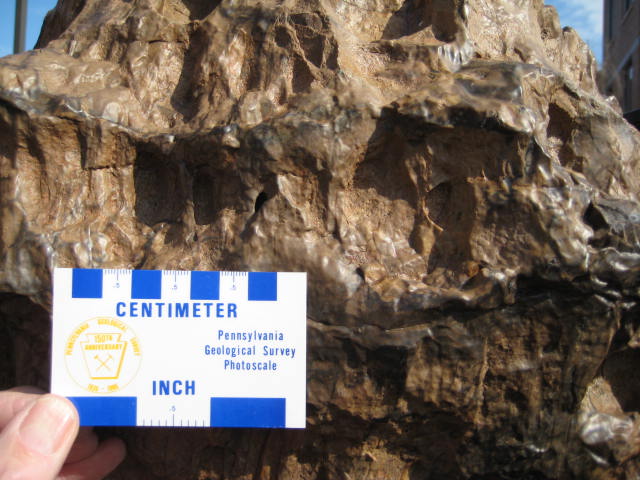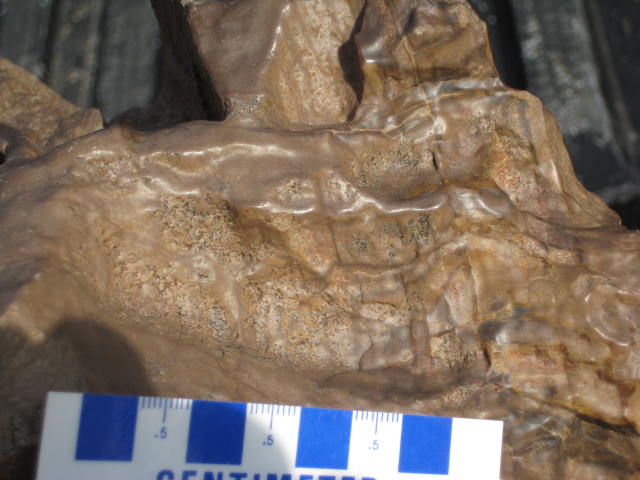Here’s a mystery rock that’s just aching to have its identity be crowdsourced:



I got these photos from Rick Diecchio of George Mason Univerisity, who got them from a local fellow who dug it up in his yard in Dale City, Virginia. Rick says:
I was stumped at first, but the more I look at it, the more I think it’s a lightning strike into sand or more likely sandstone, maybe the Cretaceous Potomac Formation.
The host rock is all sandstone. The sand appears under hand lens to be fused, and on the surface there is a chert-like coating which I think may have been the result of melting. The sample is a lot heavier than I would expect, and very well indurated.
What do you think? Are there other options? Have you ever seen anything like this? If it is a fulgurite, how common or rare is a sample this size? Feel free to share these pics with others who may be interested or who may be able to provide information.
A silcrete concretion is possible. Then it becomes significant whether or not the sand grains are fused. maybe will have to get a thin-section. There is no sign if anything fozzilized. No bone or petrified wood as far as I can tell. The size is the biggest problem for me. Most fulgurites I have seen are an order of magnitude smaller.



Any ideas, wise readers?

I have seen similar fused rock in Montana from clinker formed from burned coal seams.
It looks almost like it has concentric rings… it might be some kind of petrified wood?
While I was in Montana and was looking around at come clinker I actually came across some petrified wood in the clinker layer- so it was fused petrified wood.
I have no idea of the area, but it is just a thought.
Good luck!
You’re right about the concentric rings, Ben – cylindrical in overall form, with accompanying radial “arms” that are planar. That much seems very “log”-like. But the rock is a quartz sandstone! So it’s not any kind of petrified wood I’ve ever seen…
It’s not fused, just polished. I’d call it a silicified concretion, or perhaps just a quartzite/siliceous mudstone that preserves liesegang banding. Certainly not any sort of fulgurite.
Dear, I think that it is petrified wood. Looks identical to patagonian petrified wood. Moreover, in one of the photographies, the penultimate, clearly appears the annual rings of growth. The grease luster is typical of the rocks in deserts, under heavy impact of grains of sands. I knew many fulgurites. Their formation is almost instantaneous, and there are not time to form any concentrical structure. Only are formed by melted sand, in form of amorphous glass. If you can do a microscopic study, specially in the rings that appears in the penultimate photography, it is possible that you can identify the original cells of the wood structure. Greetings from Argentina! Miguel
thanks Miguel. You are the second person to suggest the desert-like polishing. I’ll follow up on it. Rick
This might be a zapping “kiss” from a power cable. In North Texas, my sister and her husband documented a horizontal fulgerite over 3 meters long formed by a downed powerline incinerating a Texas sandstone. Their photos are on a powerpoint slide show at http://www.google.com/url?sa=t&rct=j&q=&esrc=s&source=web&cd=1&ved=0CCMQFjAA&url=http%3A%2F%2Fgeography.unt.edu%2F~maxey%2Ffiles%2Fleftframe_files%2Flightning%2FDenton%2520Lightning%2520Strike.ppt&ei=0j9GT7PNGqfL0QGrvdCwDg&usg=AFQjCNGns8jMI5c3rOBytlVn2Eih28CLUQ&sig2=h6IIp-LLo5qG0kDOp5p0cQ
If that link goes nowhere, just google these terms together – maxey lightning texas
just wondering if there was a long axis to the vitreous clump and if so, was it horizontal or vertical.
It doesn’t look like any sort of fulgurite that I have ever seen. The edges of fulgurites tend to be very coarse not sooth like this. I have seen structures similar to this in sandstone outcrops that I was told were dewatering structures although I am not sure I believe that.